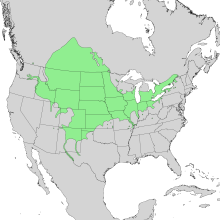Salix amygdaloides
| Salix amygdaloides | |
|---|---|

| |
| Peachleaf willow leaves | |
| Scientific classification | |
| Kingdom: | Plantae |
| Clade: | Tracheophytes |
| Clade: | Angiosperms |
| Clade: | Eudicots |
| Clade: | Rosids |
| Order: | Malpighiales |
| Family: | Salicaceae |
| Genus: | Salix |
| Species: | S. amygdaloides
|
| Binomial name | |
| Salix amygdaloides | |

| |
| Natural range | |
Salix amygdaloides, the almond leaf willow or peach leaf willow, is a species of willow native to central North America east of the Cascade Range.[2] It can be found in southern Canada and the United States—from western British Columbia to Quebec, Idaho, Montana and Arizona to eastern Kentucky.[3] As of 2022, it is presumed extirpated from the state of Kentucky.[4]
It is a small to medium-sized deciduous tree, growing to 4–20 metres (13–66 ft) tall; besides the cottonwoods, it is the largest tree native to the prairies. It has a single trunk, or sometimes several shorter trunks. The leaves are lanceolate, 3–13 centimetres (1+1⁄4–5 in) long and 1–4 cm (1⁄2–1+1⁄2 in) wide, yellowish green with a pale, whitish underside and a finely serrated margin. The flowers are yellow catkins, 3–8 cm (1+1⁄4–3+1⁄4 in) long, produced in the spring with the leaves. The reddish-yellow fruit matures in late spring or early summer, and the individual capsules are 4–6 millimetres (3⁄16–1⁄4 in) long.[5][6]
The peachleaf willow grows very quickly, but is short-lived. It can be found on the northern prairies, often near streams, and accompanying cottonwoods. As the common and scientific names suggest, the leaves bear some similarity to those of a peach and (even more so) of an almond.[2]
References
- ^ Stritch, L. (2018). "Salix amygdaloides". IUCN Red List of Threatened Species. 2018: e.T126588956A126591015. doi:10.2305/IUCN.UK.2018-2.RLTS.T126588956A126591015.en. Retrieved 11 April 2024.
- ^ a b Arno, Stephen F.; Hammerly, Ramona P. (2020) [1977]. Northwest Trees: Identifying & Understanding the Region's Native Trees (field guide ed.). Seattle: Mountaineers Books. p. 192. ISBN 978-1-68051-329-5. OCLC 1141235469.
- ^ "Salix amygdaloides". Germplasm Resources Information Network. Agricultural Research Service, United States Department of Agriculture.
- ^ Rodgers, Devin; Littlefield, Tara; McDonald, Kendall (2022). "Office of Kentucky Nature Preserves Kentucky Rare Plant List". Frankfort, Kentucky: Energy and Environment Cabinet, Office of Kentucky Nature Preserves.
{{cite journal}}: Cite journal requires|journal=(help) - ^ "Salix amygdaloides". Plants of British Columbia.
- ^ "Salix amygdaloides". Northern Prairie Wildlife Research Center. Archived from the original on 2008-03-28.
External links
 Media related to Salix amygdaloides at Wikimedia Commons
Media related to Salix amygdaloides at Wikimedia Commons Data related to Salix amygdaloides at Wikispecies
Data related to Salix amygdaloides at Wikispecies- "Salix amygdaloides". Plants for a Future.

